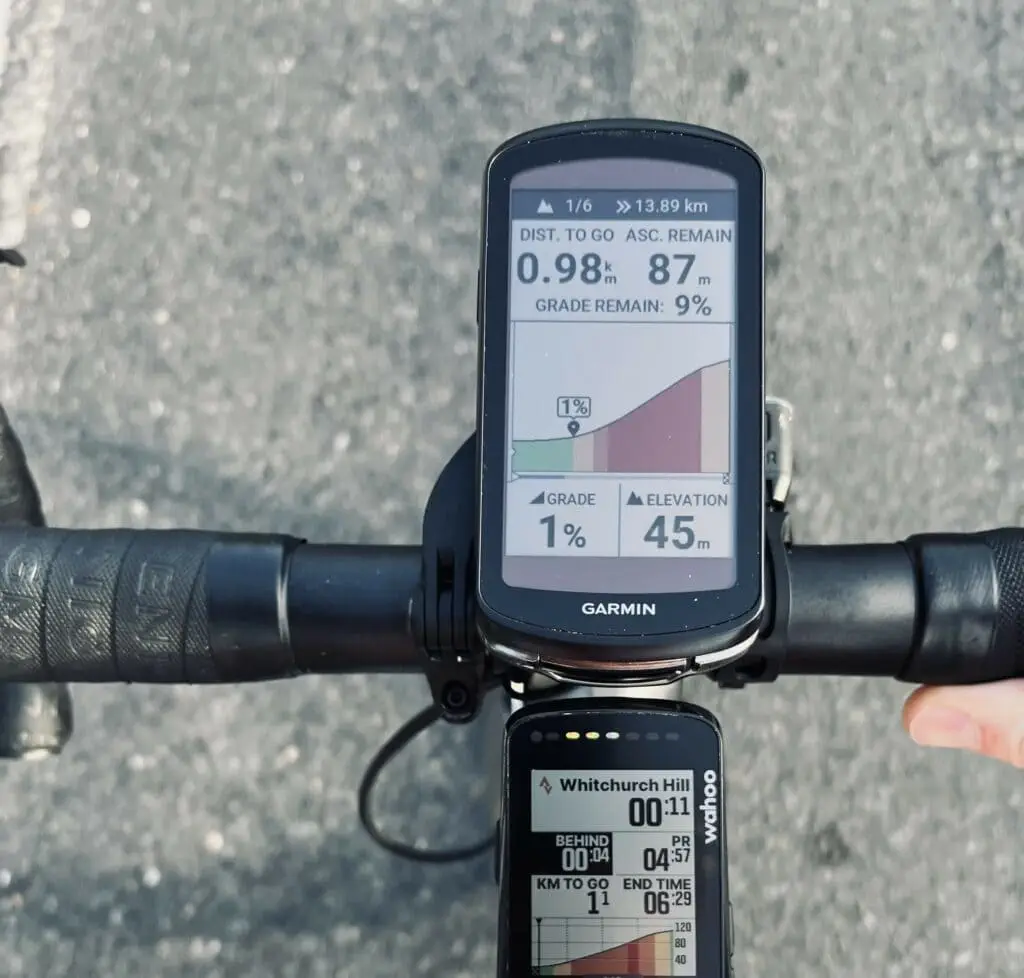Have you always wanted to know just how well your vertical climbing speed compares to other cyclists but were never sure how to measure it?
You’ve no doubt seen a VAM value displayed on your cycling app and have seen that it differs between rides, noting that it’s especially high on days when you’ve been riding hills and steep climbs, while it drops when you ride on flat terrain.
So, what is VAM and how do you put it to good use?
Key Takeaways
- VAM is an Italian acronym for velocità ascensionale media.
- It’s used to measure a cyclist’s average ascent speed.
- VAM is measured in vertical meters per hour (vm/h).
- It’s an objective measure of a cyclist’s vertical speed, overall performance, and fitness.
- VAM can also be used to estimate a cyclist’s relative power output.

What is VAM in Cycling?
VAM is used to measure a cyclist’s average ascent speed or mean ascent velocity.
It was first coined by the Italian physician and cycling coach, Michele Ferrari and is an Italian term and acronym for velocità ascensionale media.
Before the use of power meters became widespread, VAM was used to measure a cyclist’s climbing performance and helped provide power-to-weight ratio estimations.
In English, VAM translates to vertical ascent in meters. It indicates the number of meters a cyclist climbs, vertically, per hour. It, therefore, measures a cyclist’s average climbing speed or the speed of elevation gain.
VAM is measured in vertical meters per hour (vm/h).
According to Ferrari, for a professional cyclist to win the mountain stage of the Tour de France, they need to achieve a VAM of between 1650 and 1800m/hour. In contrast, average club cyclists have a VAM of around 700 to 900m/hour.
VAM is an objective measure of a cyclist’s vertical speed, overall performance, and fitness and is a metric that many cyclists would find useful to gauge and boost their performance.

How to calculate your VAM
You don’t need expensive cycling equipment, like power meters, to measure your vertical climbing speed or VAM.
Your bike’s GPS unit automatically measures the VAM values of a specific ride, while riding apps and logging sites also calculate and display a RAM value for your uphill rides.
You can also calculate VAM yourself using this simple formula:
VAM = (vertical meters climbed x 60)/time
The information you need to calculate your VAM is, therefore, the time from a start point to an end point, and the elevation gain between the two points.
Your VAM will differ depending on the gradient of each specific climb – a short climb with a high gradient will have a higher VAM value than a long climb with a less steep gradient or climb.
Therefore, the steeper the climb, the higher your VAM reading will be, but the shorter the climb will be and the less effort it will take. Shallow climbs, like the Col du Galibier, first used in the Tour de France in 1911, will have a lower VAM and require less effort.

Calculating power output (w/kg) using VAM
VAM can also be useful to estimate a cyclist’s relative power output.
After determining VAM speed, you can calculate your power output per kilogram of body mass, using this formula:
Relative power output (watts/kg) = VAM (metres/hour) / (200 + 10 × % gradient)
Relative power considers the additional power that is required to overcome the friction from the road and the extra mass of the bike. The higher the gradient of the hill or climb, the more power will be required.
To obtain an accurate calculation of relative power, an accurate VAM value and gradient of the climb are needed.
Factors that influence VAM
Several factors can impact your VAM results. These include:
- Ambient conditions
- The gradient of the climb
- Length of the climb
- Quality of the road surface
- The amount of hairpin bends on the climb.
Why is VAM Important?
VAM is a measurement of your vertical climbing rate, expressed as the number of vertical hours you climb in an hour.
It is an important metric to use if you want to compete in cycling events with a lot of climbing such as Grand Tours. It is an effective measure to predict climbing speeds, compare climbing performance, and estimate your watts per kilogram of body mass.
It helps you improve the speed of your vertical climbs and is, therefore, a critical indicator of your climbing ability.
VAM can be a valuable metric for coaches to assess a cyclist’s climbing performance. It can help a cyclist pace a climb when they do not have access to other tools or methods, or when technology fails.

Limitations of VAM
VAM is only useful when you are riding hills, as flat terrains produce useless VAM data.
It won’t be of any value when you are traveling long distances horizontally., as VAM performance is only of value for rides with hills that offer steeper climbs.
How to Improve VAM
To improve your VAM, keep in mind that you will have to compare like with like.
Because VAM scores increase with gradient, you can’t compare VAMs across climbs, different hills, or whole rides. You will have to focus on and only work on improving RAM for a specific climb, over a set distance and gradient.
Focus on improving your VAM on climbs you ride regularly. This will allow you to compare the different VAM values you obtained on that specific climb. Don’t try to hit the highest possible number – rather focus on gradually improving your VAM for the preferred hill.
If you don’t have access to riding apps, manually calculate your VAM scores, and note it down as the number you’d like to beat next time. This will allow you to consistently monitor your improvement.
To increase your VAM and increase your climbing power, focus on increasing your power and decreasing your weight. This comes down to training, to increase strength and stamina.
To decrease your weight, make sure that any weight loss you undergo is done carefully. Keep eating a healthy, balanced diet even if you decide to shed some pounds.
Tools for Measuring VAM
There are several tools you can use to measure your VAM, including:
- A GPS bike computer (my goto is the Wahoo ELEMNT Bolt)
- Smartphone cycling apps
- Ride logging sites
- An online map with altitude and a stopwatch.
Cyclists tend to ignore the usefulness of VAM when they have a power meter on their bikes.
When you do not have access to a power meter because it fails, or you are renting a bike that doesn’t have a good power meter installed, VAM is a great tool to use when want to measure and improve your vertical climbing power and speed.

FAQs
What is a good VAM?
Professional cyclists who compete in Grand Tours typically clock high VAMs of around 1500m/h on mountain stages. Most club cyclists, on average, record VAM values of between 700 and 900m/h.
How do I select a climb to record my VAM?
Search for short sharp climbs and use a climb that’s less than one kilometer with an average gradient of over 15%. A climb that sees an effort of around one minute works best. When recording your VAM, ensure you’re warmed up, but not fatigued.
